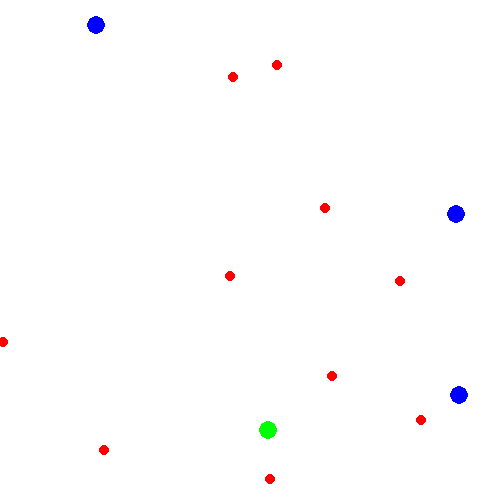Hi CS 224W staff! Thank you for taking the time to look at our project.
To start, make sure you have Miniconda installed.
Then, run . ./setup.sh to set up the conda environment.
Next, run python main.py --show --model=gnn --env=greedy
If you see something like this, you're good to go!
For our final CS 224W project, we wanted to use graph neural networks with reinforcement learning. The game of agar.io — in which circular blobs compete to grow the largest by consuming pellets and each other — seemed a perfect application. To make the game easier to learn, we made several modifications to the original game:
- restricted the move space to 5 possible actions: no-op, up, down, left, and right
- removed the split and eject actions
- shrunk the map size
- reduced the number of players to 1-4
- reduced the number of pellets to 10
- reduced frame rate to 10 fps
With these modifications and using REINFORCE for training, we were able to train an MLP model to perform comparably to a greedy agent in the pellet collection environment, but results with our Heterogenous GNN were far less promising. Potential future improvements may include:
- parallelizing episodes to stabilize training
- using more powerful reinforcement learning algorithms (e.g., Actor-Critic, DQN, PPO, etc)
- filtering graph edges based on distance or via pooling
- allowing the GNN to learn node and edge features
- incorporating attention (either learned or proportional to 1/dist)
Unfortunately, we weren't able to explore these during the project. The sequential and time-intensive nature of RL training made experimentation difficult.
For more details about the project and its results, check out (TODO: link medium article)
To train the GNN model yourself in a self-learning environment, run python main.py --train --model=gnn --env=sel --episodes=1000000. To view the model's progress, run tensorboard --logdir=runs and open up the provided local address in any browser.
Everything in this repository can be controlled using main.py:
- to train a model, run
python main.py --train <arguments> - to test an agent, run
python main.py --test <arguments> - to display an agent for one episode, run
python main.py --show <arguments>
--env=['pellet', 'greedy', 'self'], required: the type of simple agar environment to run in- 'pellet': collect as many pellets as possible without competition from other players
- 'greedy': fight to consume pellets and survive against greedy opponents that always move toward the closest pellet
- 'self': control all agents simultaneously in this multi-agent self-learning environment
--agent=['learning', 'greedy', 'random'], optional (default: 'learning'): the type of agent to run--model=['mlp', 'gnn'], optional, the type of model used by a learning agent--episodes, optional (default: 10000000), the number of episodes to run for training or testing--k_pellet, optional (default: -1), the maximum number of pellet locations and masses provided as input to the mlp model--k_player, optional (default: -1), the maximum number of player locations and masses provided as input to the mlp model
simple_agar:envscontains the base gymnasium environment and endpoints used to make experimental environmentswrappercontains environment wrappersagentscontains baseline agents and learning agent
modelscontains the MLP and GNN models used to train the learning agentconstants.pycontains constants used throughout the repositorytrainer.pycontains methods used to train the models
